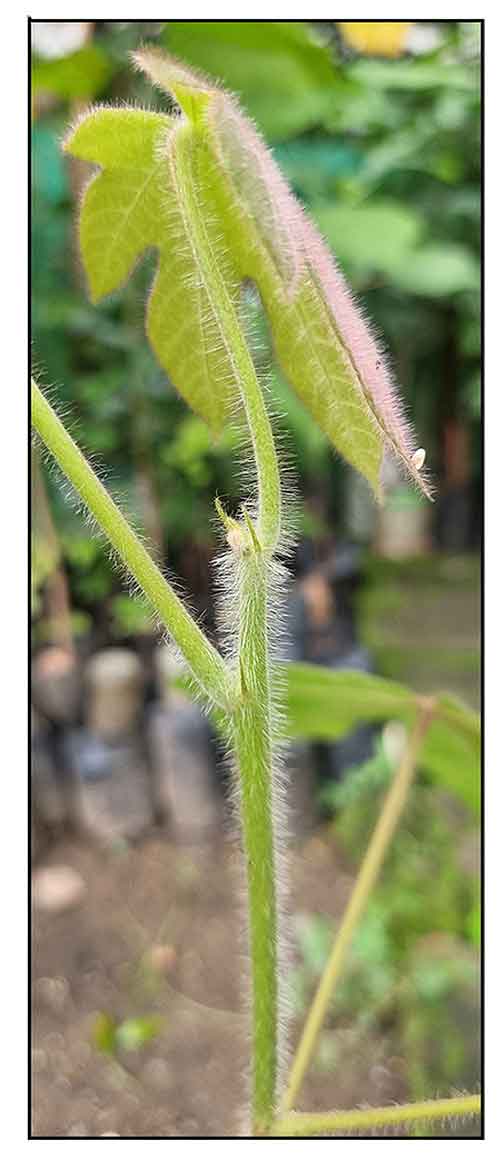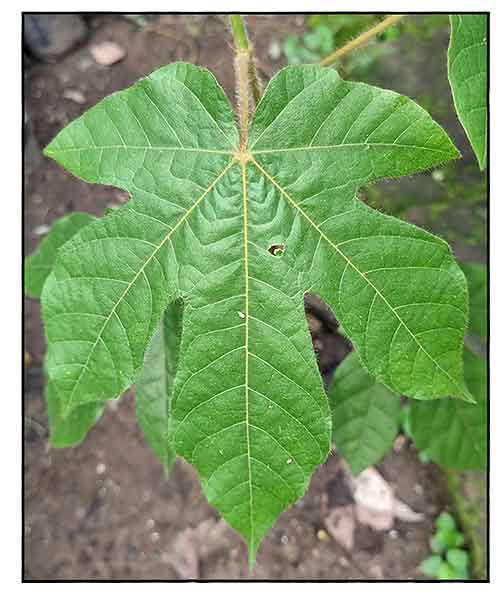 Gen info Gen info
- Sterculia is a genus of flowering plants in the mallow family, Malvaceae. Members of the family are colloquially known as tropical chestnuts. Sterculia may be monoecious or dioecious, and the flowers unisexual or bisexual. (2)
- Plants of the World Online lists 182 accepted species.
- Etymology: The genus name Sterculia is named after the Roman god Sterculius, the god of manure, referring to the foul-smelling flowers of some species in the genus. The species epithet comosa probably refers to having abundant hairs.
Botany
• A medium-sized to fairly large tree up to 40 m tall, with bole up to 100 cm in diameter, bark surface smooth and brown, inner bark pale brown, twigs stout, c. 24 mm in diameter; leaves simple and entire, ovate, rarely suborbicular, 15—30(—40) cm 12—30(—40) cm, generally cordate at base, generally densely stellate or peltate-stellate appressed grayish hairy below, rarely glabrous, petiole 8—26 cm long, stipules caducous; inflorescence axillary or subterminal, paniculate, many-branched, erect; calyx with obconical or campanulate tube densely pubescent inside and 5 triangular or ligulate recurved lobes about as long as the tube, male flowers with 7—10 anthers; follicles 2—5, obovoid or oblong, c. 4.5 cm long, red; seed ellipsoid, c. 1.5 cm long, black. (2)
Distribution
- Native to the Philippines.
- In primary lowland forests, up to 700 m, on clayey, sandy or rocky soils.
- Also native to Maluku and Sulawesi. (1)
Constituents
- Methanol extract yielded total phenols of 723.61 mg GAE/gr, total flavonoids of 28.96 mg QE/gr extract. (see study below) (3)
Properties
- Studies have suggested antioxidant, arginase inhibitory, anti-CoV2, antifungal properties.
Parts used
Seeds, wood.
 Uses Uses
Edibility
- No report or study on edibility of this species. However, large seeds of many species in this genus are reportedly edible, usually cooked, with a flavor similar to peanuts.
Folkloric
- No reported folkloric medicinal use in the Philippines.
- Used for treatment of fever, headache, skin diseases.
Others
- Wood: Used for light construction.
- Fiber: Bark yields a fiber; used for making rope.
 Studies Studies
• Antioxidant / Arginase Inhibitory / Anti-CoV-2 Protein Potential: Arginine metabolism plays an important role in vascular function. Arginase is the enzyme associated with metabolism of arginine. Study evaluated the arginase inhibitory and antioxidant activity of Sterculia comosa and its binding affinities to arginase. The methanol extract was most active with IC50 of 2.787 µg/ml for arginase inhibitory activity and IC50 of 4,199 µg/ml for DPPH scavenging activity. Analysis yielded LKC4.4.6 ((-)-2-(E)-caffeoyl-D-glyceric acid) and KC4.4.5.1 (trans-isoferulic acid) with arginase inhibitory activity of 98.03 µg/ml and 292,58 µg/ml, respectively. Antioxidant activity by DPPH was 48.77 and 88.08 µg/ml respectively; and 16.4 FeEAC mol/g and 15.79 FeEAC mol/g, respectively. The isolate trans-isoferulic acid predicted good interaction to arginase. Isolate KC$.4.6 showed good interaction to PLPro of SARS CoV-2 PLpro. Both isolates did not show good interaction to 3CLPro, nsp12, and Spike protein of SARS CoV-2. (3)
• Arginase Inhibitory / Wood: Study evaluated the arginase inhibitory activity from genus Sterculia plants. Methanol extract of Sterculia comosa wood and leaves showed arginase inhibitory activity. Wood showed highest content of total phenols, antioxidant activity and arginase inhibitory activity. (4)
• Endophytic Bacteria / Antibacterial / Seed: Endophytic bacteria isolated from various kind of plants can yield active compounds with antibacterial activity. Study evaluated endophytic bacteria from Faloak seed and its inhibitory activity against S. aureus and E. coli. Results showed endophytic bacteria isolate of Faloak seed with code S1 had similarity with Enterobacter xiangfangensis strain 10-17 by 93%. Results provide information on the potential antimicrobial ability of Faloak plants for the discovery of new antibiotic compounds to help overcome microorganism resistance to antibiotics. (5)
• Antifungal: Study evaluated the toxicity of bark, leaves, and seed extracts of Sterculia comosa and it antifungal activity using agar well diffusion method. Results showed the diethyl ether (DE) fraction of seeds was more effective in inhibiting Candida albicans growth. Subfraction DE7 showed higher potency in C. albicans growth inhibition. LCMS, FTIR, and proton NMR analysis suggested 3-hydroxyocta-decanoic acid (C18H36O3) was the compound mainly responsible for antifungal activity. (6)
Availability
Wild-crafted.
|

![]()



 Gen info
Gen info Uses
Uses
